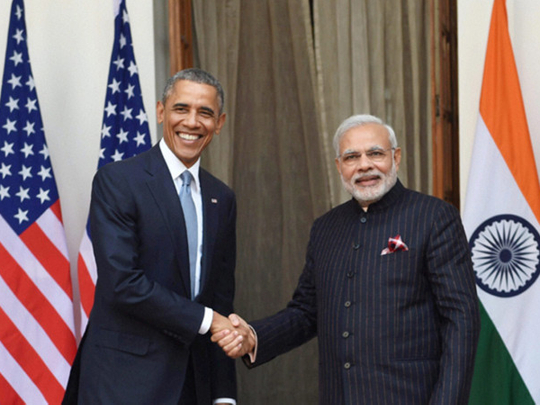
India’s foreign policy is going through a seismic shift and it is reasonable to ask if a Prime Minister Narendra Modi doctrine is slowly evolving. India has never had a prime minister as intrepid as Modi and none who relishes the media glare as much — imagine his shy and retiring predecessor and then Modi in his signature suit hugging Obama — the difference is startling.
The outlines of the Modi doctrine are hazy, but one thing is clear; the keystone of this emerging security architecture is the centrality of Indo-US relations. It does seem as though every strategic challenge India faces is being looked at through this prism; be it China, climate change, nuclear materials and arms control issues, logistics support facilitation for disaster management relief operations or keeping the sea lanes open for maritime trade. India is almost a Nato ally, albeit circumscribed by its geography. And all of this under the watch of a prime minister who until three years ago was shunned by the United States and even denied a visa to enter the country. This is no rebalancing or pivot, Modi is aiming to being a game changer.
The question to be asked is what are the consequences of this seismic shift? Will India be asked to fight the US’ wars in future? Is it then just a matter of time before we see the Indian Army in Fallujah? Far-fetched, but not impossible. This would be sacrilege, upending India’s holy grail of strategic autonomy. Jawaharlal Nehru, India’s first prime minister, said: “Slaves ourselves, it has been our degrading function to help in the enslavement of others for the benefit of a third party.”
Indian soldiers were at the vanguard of British power-projection across Asia and Africa for decades until 1947. India’s Muslim population adds another dimension to these debates, indeed with respect to Afghanistan, where Indian stakes are high and where America has already tried to enlist India.
The miscalculation by India’s foreign office for gaining entry to the Nuclear Suppliers Group (NSG) has set off a series of op-eds in Indian media. Some critical — Pratap Bhanu Mehta even terming the NSG bid “machismo more than maturity” — others supportive and one could use this fiasco as a backdrop to deconstruct the proposition that India has willy-nilly become a defacto ally of the US. India’s Foreign Ministry says this NSG muddle is temporary and very much a work-in-progress as India’s application would be up for review again later in the year. Broadly the ‘for’ and ‘against’ arguments revolve around three key issues: The waiver was not important and political capital was wasted on the misadventure; next, inadequate preparatory work was done before moving the application — T.P. Seetharaman’s Hindu piece; and has India played into the hands of the US strategic establishment? Ergo the collapse of India’s Sisyphus-like pursuit of strategic autonomy.
The NSG was specifically formulated to keep India out. It is a key cartel to lay down the rules for nuclear commerce and is, along with other treaties such as the Missile Technology Control Regime, critical for India to achieve self-sufficiency in these strategic domains.
A one-time waiver that India received in 2008 is not enough, and in any case the Manmohan Singh government’s pusillanimous approach after that waiver, through the introduction of the nuclear liability law, virtually made that concession all but infructuous. So, in balance, it would appear that the NSG bid was necessary and much as one could argue it was perhaps a hasty bid, don’t forget there is a US president who leaves office in January 2017 and the Modi-Obama bear hugs will have to be repeated with the new president. And no one is sure whether the Modi charm offensive will work with the new incumbent in the White House.
The seminal question to be asked in all these debates centres on strategic autonomy. The unvarnished truth is India will need to water down and even abandon this oft-repeated mantra if it is to meet the challenges of China’s rise. India simply does not have the wherewithal to withstand the Chinese hegemony. The Chinese economy is five times that of India’s, its military outreach is gargantuan compared to India’s, the military-industrial complex backing this outreach technologically is far superior. Yes, India can theoretically catch up, but can it really? Is India capable of sustained double-digit growth during the next 20 to 30 years to make its economy a global powerhouse?
Much of India’s strategic community and particularly those grounded in liberal values and with Cold War memories of America’s double-speak and nurtured in the lofty ideals of Nehru, shudder at the thought of aligning itself so closely with the US. And they well be right, for to reach out for the US’ hands each time India faces an international challenge such as the NSG waiver is to enter unchartered waters. The US is not a faithful ally as history has shown time and again, but who can deny that Uncle Sam is the best of the worst.
Ravi Menon is a Dubai-based writer, working on a series of essays on India and on a public service initiative called India Talks.







